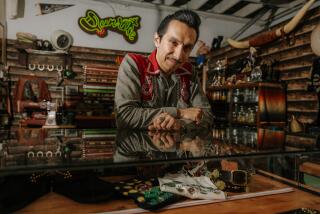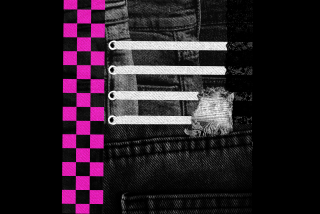Skin-Deep Symbolism
WASHINGTON â Imagine a carefully fashioned coat hanger, slow-roasted over the blue-green flame of a Magic Chef range, heading for the fleshy expanse of your upper arm, your chest or the side of your behind.
For a fraction of a second, you can feel the heat before it touches your skin. Your heart races and instinctively you want to draw back. But you donât. Because you want your brand to be sweet. Or if you think youâll move, you brace yourself, holding onto a sink or table, or perhaps you get somebody else to hold you down.
Then comes the âhit,â a quick âPssssssst.â Or maybe itâs a âcrackleâ or âpop,â not unlike the sound of Rice Krispies soaking in a bowl of milk. They say it doesnât really hurt. But the smell of burning flesh can be weird. Especially when itâs yours.
Imagine being branded.
Many people watching this yearâs NCAA Final Four tournament caught sight of the big horseshoe-shaped scar on the left arm of University of North Carolina point guard Shammond Williams. Michael Jordanâs brand, hidden on his chest, is more discreet. Dallas Cowboys running back Emmitt Smith sported a brand on his left arm for a 1993 cover of Sports Illustrated. Other folks have Greek letters melted into their calves or seared into their forearms.
Although doctors warn there can be complications--infection, excessive scarring, designs gone wrong--around the country lots of people get branded. For some black Greek fraternity members (and fewer white ones) itâs a long-standing tradition, but experts say itâs also become something of a fad.
Gang members brand themselves to claim their set, while for others, brands are an extension of green Mohawks and multiple nose rings. Branding can forge a connection. But while brands might be spiritual, sexual or ceremonial, theyâre always hot.
*
As Myyucca Sherman strolls across the Howard University campus here, his baby dreadlocks standing at attention, he stops occasionally to slap hands with a buddy or trade barks with another âQue dogâ who spots his bright purple sweat shirt emblazoned with gold Greek letters.
Sherman, 19, has been a âQue,â a member of Omega Psi Phi fraternity, since spring of last year, and heâs got three brands--double, interlocking Omegas on his chest, and a large Omega with a small Greek A inside, for Alpha chapter, in the middle of his left arm. Of his initiation class of nine men, all chose to get branded.
It was the second time an organization had made a permanent impression on him.
Sherman is reluctant to show the 3-inch, five-point star that rides high on his left hip. He got that one at 13 to mark his membership in the Black Gangster Disciple Nation, a gang in his Akron, Ohio, hometown. âI was branded. . . with thick paper clips.â
Sherman credits the pre-college program Upward Bound and rites-of-passage activities in high school with turning him from his gangster ways. He entered the University of Akron at 16 and transferred to Howard a year later.
After joining the fraternity at Howard, he says, âinitially, I wasnât going to get a brand, but I thought about it and equated the whole fraternity life as another rite of passage. This was more ritualistic and traditional than the juvenile self-mutilation. It had deeper meaning, more history.â
In the last 10 years, branding has become a typical form of gang âtagging,â says Michael Borrero, a professor and director of the Institute for Violence Reduction at the University of Connecticut who has worked in gang outreach for more than 30 years. âItâs a ritual to say we are brothers, we are sisters, you are officially part of us,â Borrero says.
Michael Lyles, 35, a Washington child welfare attorney who also heads his own Maryland law practice, has studied the historical origins of fraternity branding and its relation to African scarification practices and says burning carries a symbolism that crosses many cultures.
âHistorically, branding probably came in vogue in the 1950s and 1960s,â says Lyles, an Omega since he was 17 who has brands on his right biceps and over his heart. âIt took on a kind of widespread usage--mainly among the Omegas first, then the Kappas [Kappa Alpha Psi fraternity] and Alphas [Alpha Phi Alpha fraternity] began to do it also. One of the things that I guess solidified branding as something to do is the things that our fraternity is based on--manhood, scholarship, etc. It seemed to signify the âtill the day I die-nessâ of it all.â
Typically, according to Lyles, each chapter has somebody to turn to for branding. At Howard, most folks call him âNutâ for his willingness to go to extremes. But the brothers of Omega Psi Phi also know the 6-foot-3 graduating senior majoring in sculpture and psychology by another name. Sherman and others went looking for him when they wanted a lasting way to punctuate their allegiance to the frat.
Because everybody knows Nut is a âhit man.â
Nut, who asks that his name not be used so that his branding and his art career remain separate, has perfected his craft; heâll fashion a wire coat hanger into a plain Omega, make it asymmetrical for the âstepping Queâ effect, or customize it with a dramatic thunderbolt.
Although thereâs a certain artistry in the design, the skill is in the hit. After his 1995 initiation, Nut learned by carefully watching another hit man. And by being branded. Repeatedly. One time for each of his fellow Omega initiates.
Seven brands for seven brothers.
Of his seven brands, three are on his back and four run diagonally across the left side of his behind: big, interlocking Ques that seem to want to dance their way to his spine.
He usually makes his brands on the spot, but he happens to have a few on hand in his kitchen cabinet. Big ones. âIf you really want to show youâre a Que, Iâm not going to use some little circle,â he says. âIf your arm isnât big enough, Iâm going to have to use your chest.â
Although fraternity members with brands talk about their brotherhood as sacrosanct, branding has also become a pop culture expression of machismo, according to Walter Kimbrough, a director of student activities and leadership at Old Dominion University who wrote his dissertation on black Greek letter organizations.
Kimbrough stresses that while some black Greek letter organizations have been censured for excessive hazing practices, branding is not involved. It is not sanctioned by the governing bodies of any of the national Greek letter organizations and is âofferedâ only after initiation.
*
In one scene from the 1988 Spike Lee movie âSchool Daze,â a girl is shown licking a brand on the chest of a brother from the fictitious Gamma Phi Gamma fraternity. Duane Filey, 27, a fourth-grade teacher at James McHenry Elementary School in Lanham, Md., and a member of Kappa Alpha Psi fraternity, acknowledges wryly that, for some reason, women seem to find his scar compelling. Still, Filey, who has a diamond with a K inside branded on the left side of his chest, now says he regrets having it done.
âI was young and thought it was a cool thing to do,â Filey says. âI was like âIâm in Florida, I can have my shirt off and the babes will look at it.â Women are into that. The brand, the frat . . . it was a conversation piece, they wanted to touch it.â
He now calls the practice barbaric. âAs I got older, I started thinking about slavery and that sort of thing. This clearly isnât for that purpose, but now I think people have just gotten out of control. Itâs a big fad right now.â
More to Read
Go beyond the scoreboard
Get the latest on L.A.'s teams in the daily Sports Report newsletter.
You may occasionally receive promotional content from the Los Angeles Times.










